
Arab Journal of Nutrition and Exercise
ISSN: 2518-6590
Groundbreaking research on nutrition, physical activity, and public health from across the Arab world.
Celiac Disease or Gluten Sensitivity? A Mini Update Review
Published date: Nov 16 2017
Journal Title: Arab Journal of Nutrition and Exercise
Issue title: AJNE: Vol 2, No 2 (2017)
Pages: 58-61
Authors:
Abstract:
Celiac disease is described when some people have with foods that contain gluten. Gluten is a type of protein. It's found in the grains wheat, barley and rye. It has antigenic properties and usually triggers an immune response. On the other hand, gluten sensitivity or intolerance is a similar condition that causes a person to react to gluten found in the above food items described.
Even though the clinical symptoms are similar to both conditions, the pathology, diagnosis and treatment is different, thus it is very important to get the correct diagnosis. The purpose of this mini review is to compare the main aspects of these two conditions.
References:
[1] C. Catassi, S. Gatti, and E. Lionetti, “World perspective and celiac disease epidemiology,” Digestive Diseases, vol. 33, no. 2, pp. 141–146, 2015.
[2] Celiac Disease Center, A Brief History of Celiac Disease. University of Chicago, 2007, vol.7(3): pp.1-4.
[3] A. Fasano, A. Sapone, V. Zevallos, and D. Schuppan, “Nonceliac gluten sensitivity,” Gastroenterology, vol. 148, no. 6, pp. 1195–1204, 2015.
[4] H. Garnier-Lengliné, N. Cerf-Bensussan, and F. M. Ruemmele, “Celiac disease in children,” Clinics and Research in Hepatology and Gastroenterology, vol. 39, no. 5, pp. 544–551, 2015.
[5] K. Giersiepen, M. Lelgemann, N. Stuhldreher et al., “Accuracy of diagnostic antibody tests for coeliac disease in children: summary of an evidence report,” Journal of Pediatric Gastroenterology and Nutrition, vol. 54, no. 2, pp. 229–241, 2012.
[6] S. Guandalini and A. Assiri, “Celiac disease: A review,” JAMA Pediatrics, vol. 168, no. 3, pp. 272–278, 2014.
[7] S. Husby, S. Koletzko, IR. Korponay-Szabó et al., “European Society for Pediatric Gastroenterology, Hepatology, and Nutrition Guidelines for the Diagnosis of Coeliac Disease,” J Pediatr Gastroenterol Nutr, vol. 54, no. 1, pp. 136–160, 2012.
[8] Y. Junker, S. Zeissig, S.-J. Kim et al., “Wheat amylase trypsin inhibitors drive intestinal inflammation via activation of toll-like receptor 4,” The Journal of Experimental Medicine, vol. 209, no. 13, pp. 2395–2408, 2012.
[9] K. M. Kemppainen, K. F. Lynch, and E. Liu, “Factors that Increase Risk of Celiac Disease Autoimmunity Following a Gastrointestinal Infection in Early Life,” Clin Gastroenterol Hepatol, vol. 15, no. 5, pp. 694–702, 2017.
[10] J. F. Ludvigsson, C. Sellgren, B. Runeson, N. Långström, and P. Lichtenstein, “Increased suicide risk in coeliac disease-a swedish nationwide cohort study,” Digestive and Liver Disease, vol. 43, no. 8, pp. 616–622, 2011.
[11] C. Ortiz, R. Valenzuela, and A. Y. Lucero, “Celiac disease, non-celiac gluten sensitivity and wheat allergy: comparison of 3 different diseases triggered by the same food,” in Celiac disease, vol. 88, pp. 417–423, Rev Chil Pediatr, 2017.
[12] E. Tonutti and N. Bizzaro, “Diagnosis and classification of celiac disease and gluten sensitivity,” Autoimmunity Reviews, vol. 13, no. 4-5, pp. 472–476, 2014.
[13] A. Sapone, K. M. Lammers, G. Mazzarella et al., “Differential mucosal IL-17 expression in two gliadin-induced disorders: Gluten sensitivity and the autoimmune enteropathy celiac disease,” International Archives of Allergy and Immunology, vol. 152, no. 1, pp. 75–80, 2010.
[14] A. Sapone, J. C. Bai, C. Ciacci et al., “Spectrum of gluten-related disorders: consensus on new nomenclature and classification,” BMC Medicine, vol. 10, article 13, 2012.
[15] L. E. White, V. M. Merrick, E. Bannerman et al., “The rising incidence of celiac disease in Scotland,” Pediatrics, vol. 132, no. 4, pp. e924–e931, 2013.